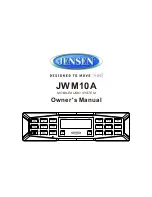
15
4. Microphone Operation
a. Turn on the Link 2 by sliding the ON/STANDBY/OFF SWITCH (41) to the
STANDBY position (transmitter on, audio muted) or the ON position (transmitter
and audio both on). The LOW BATTERY INDICATOR LED (40) will give a single
quick flash, indicating usable battery strength. In case of dead or low battery,
the indicator will either not go on at all or stay on continuously, indicating a bat-
tery voltage below 7V. If this occurs, replace with fresh 9V battery. Remember to
turn the transmitter off when not in use.
b. The Link 2 is now ready to use. Most or all of the RF DISPLAY LEDs (4) on that
channel of the Encore DUET receiver should now be lit, indicating a received
signal from that transmitter. When ready to speak, slide the transmitter switch
to the ON position and adjust the volume of that channel of the receiver as per
the
Audio Output Microphone Connection
section of the above Encore DUET
receiver instructions. The appropriate AF LEVEL LED DISPLAY (5) on the Encore
DUET receiver will light up to 5 LEDs (4 green and 1 red) for all input signals.
Occasional flickering on and off during use of the top red LED indicator in this
display is normal, however if the red LED stays on continuously, it means the
signal is too loud and there is the possibility of overload distortion. Re-position
the microphone farther from the source or adjust the Link 2 transmitter gain with
the VOLUME LO/HI GAIN SWITCH (39). Set for the maximum possible level
without noticeable distortion on the high level peaks. Set the GAIN SWITCH to
LO to decrease the audio level, and set the GAIN SWITCH to HI to increase the
audio level. The red LED indicator should flicker only on the loudest inputs.
(Note: Observe care in selecting P.A. volume, transmitter location and
speaker placement so that acoustic feedback (howling and screeching)
will be avoided. Please also observe the pickup patterns of the micro-
phone selected: omnidirectional mics pick up sound equally from all
directions and are prone to feedback if not used carefully. Unidirectional
mics are more resistant to feedback, but pick up sound sources best that
are directly in front of the mic. Also, mics that are farther from the sound
source, such as lavaliers, require more acoustic gain and thus are also
more prone to feedback than close-source mics such as handheld or head-
worn mics that are used close to the mouth.)
(Note: Microphone elements can easily be destroyed by the buildup of
salts and minerals from perspiration and saliva. It is good practice to put
6
5. Connecting the Audio Output
The Encore DUET receiver provides both a fixed mic level BALANCED AUDIO OUT-
PUT XLR (14) for each channel and an adjustable line level A + B UNBALANCED
AUDIO OUTPUT 1/4" JACK (13) which provides a mixed (summed) Ch A plus Ch B
output signal. The mixed level from the A + B UNBALANCED OUTPUT is controlled
by the rear panel VOLUME CONTROLS (6) for each channel.
(Note: As when mak-
ing any connection, make sure the amplifier or mixing board volume is at the
minimum level before plugging in the receiver to avoid possible sound system
damage. Also make sure that the phantom power on the input of the mixer is
turned OFF before making connection to the receiver.)
a. Instrument Connection (using the WGT instrument transmitter)
Insert an audio cord with a 1/4" mono phone plug in the A + B
UNBALANCED OUTPUT JACK (13) on the rear panel of the receiver. Plug the
other end of the cord into an amplifier, effects, or mixing board. Adjust the
appropriate VOLUME CONTROL (6) for the channel being used on the Encore
DUET receiver clockwise to about 3/4 rotation, until the mixed volume level is
comfortable for your application. This setting is roughly equivalent to a direct
instrument cord connection. Turning the volume up to maximum will provide
4dB gain over a cord.
(Note: Since this a mixed output of Ch A & Ch B,
both channels with be processed simultaneously by the amplifier and/or
effects connected to, which may not be appropriate for your application.
b. Microphone Connection (using the WLT transmitter with either a headset or
lavalier microphone or the WHT handheld microphone transmitter)
For microphone use, either the BALANCED MIC AUDIO OUTPUT XLRs (14)
or the 1/4" line level A + B UNBALANCED OUTPUT (13) can be used. The
XLR output is set at a non-adjustable microphone level, similar to hardwired mic
levels. Plug an XLR connector into either or both of the XLR OUTPUT JACKS on
the rear of the unit and plug the other end into your amplifier or mixing board.
(Note: Make sure the phantom power on your mixing board is turned off
and the volume is turned down when making connections.)
For your convenience, the XLR output levels are preset at the factory and are
not adjustable with the receiver volume controls. To use the 1/4" A + B
UNBALANCED OUTPUT JACK (13), follow the instructions for the
Instrument Connection(above), except start with the receiver volume at 1/2
MAX and adjust the volume control for each channel until the mixed Ch A &
Ch B volume level is optimal. If the volume controls are set too high, you may
overload your mixer or amp.




























